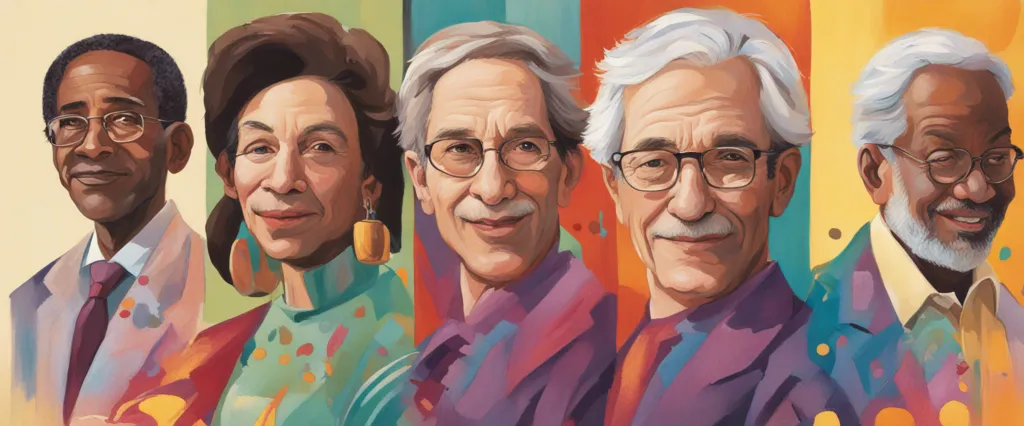In “The Definitive Book of Body Language” by Haemin Sunim, readers are invited to embark on a journey of self-discovery, finding solace in the present moment. Drawing from his experiences as a Buddhist monk and his deep understanding of the human psyche, Sunim offers profound insights and practical advice to cultivate peace, happiness, and mindfulness in today’s fast-paced world. Through this captivating book, he holds a guiding light for those overwhelmed by the constant noise of daily life, reminding us of the beauty and wisdom that can be found when we simply slow down. Haemin Sunim is not only an esteemed Buddhist monk but also a renowned writer and lecturer. With his engaging storytelling style, he has become a trusted source of wisdom, encouraging millions around the world to seek a meaningful life filled with love and serenity.
Chapter 1: Embracing Stillness: Discovering the Power of Slowing Down and Embracing Moments of Stillness in Daily Life
Chapter 1 of “The Things You Can See Only When You Slow Down” by Haemin Sunim explores the concept of stillness and the transformative power it holds in our fast-paced and hectic lives. The chapter begins by acknowledging the constant rush we find ourselves in, with overflowing schedules and endless distractions that consume our attention. Sunim emphasizes the importance of embracing moments of stillness in order to find peace and clarity amidst the chaos.
The author highlights the contemporary tendency to equate busyness with productivity and success, causing individuals to ignore their basic human need for reflection and rest. By promoting the practice of slowing down and cultivating stillness, Sunim presents an alternative perspective that champions the beauty and wisdom that can only be found in the present moment.
Sunim shares various instances when embracing stillness can be beneficial, such as during periods of difficulty and grief. He notes that by taking the time to be fully present with our emotions, accepting them rather than suppressing them, we can gradually find healing and inner peace. Moreover, the chapter stresses the importance of letting go of attachments and expectations, allowing oneself to experience life without constantly striving for something more.
In summary, Chapter 1 of “The Things You Can See Only When You Slow Down” urges readers to break away from the fast-paced rhythm of life and to instead embrace moments of stillness. By doing so, we can find solace, gain clarity, and rediscover the depth and beauty of the present moment.
Chapter 2: Cultivating Mindfulness: Exploring the Practice of Mindfulness and Its Ability to Bring Clarity and Awareness to the Present Moment
Chapter 2: Cultivating Mindfulness – Exploring the Practice of Mindfulness and Its Ability to Bring Clarity and Awareness to the Present Moment.
In this chapter, Haemin Sunim delves into the concept of mindfulness and its transformative power in bringing clarity and awareness to the present moment. He emphasizes the importance of cultivating mindfulness to counteract the chaotic and distracted nature of modern life.
Sunim begins by explaining that mindfulness is the practice of being fully present and engaged in the current moment, without judgment or attachment. It involves directing one’s attention to the present experience, whether it be a mundane daily activity or a moment of contemplation. By embracing mindfulness, individuals can escape the burden of regretting the past or worrying about the future.
The author introduces various mindfulness techniques and practices, such as focusing on the breath, being aware of body sensations, and observing thoughts and emotions without getting entangled in them. He encourages readers to integrate mindfulness into their daily routines, suggesting that even simple actions like eating or walking can become profound experiences when approached with mindfulness.
Sunim also highlights the role of mindfulness in developing self-awareness and cultivating compassion towards oneself and others. He explains that by being fully present in each interaction and observing one’s internal reactions, individuals can develop empathy, understanding, and deep connections with others.
Throughout the chapter, Sunim shares personal anecdotes, insights, and practical advice to deepen the reader’s understanding of mindfulness. He emphasizes that mindfulness is not only a tool for personal growth and self-care but also a path towards living a more fulfilling and engaged life.
In conclusion, Chapter 2 of “The Things You Can See Only When You Slow Down” explores the practice of mindfulness, its ability to bring clarity and awareness to the present moment, and its transformative impact on well-being and relationships. Sunim provides valuable guidance and encouragement for readers to embrace mindfulness as a key to finding serenity and happiness in their lives.
Chapter 3: Finding Balance: Nurturing a Balanced Life by Prioritizing Self-Care, Relationships, and Personal Growth
Chapter 3 of “The Things You Can See Only When You Slow Down” by Haemin Sunim focuses on the importance of maintaining balance in our lives through self-care, nurturing relationships, and personal growth. Sunim begins by acknowledging that in our busy and hectic lives, we often neglect these essential aspects, resulting in stress and unhappiness.
The chapter emphasizes the significance of self-care as a foundation for overall well-being. Sunim suggests that we should take time for ourselves, engaging in activities that bring us joy and recharge our spirits. Whether it is simply sitting alone in silence or pursuing a hobby, self-care helps us regain perspective and cultivate a sense of peace amidst the chaos of daily life.
Additionally, Sunim highlights the value of nurturing and investing in our relationships. He emphasizes that genuine connections with others bring us joy, support, and strength. By being present and attentive when interacting with loved ones, Sunim suggests we can deepen these relationships and create a sense of belonging and fulfillment.
Furthermore, the chapter emphasizes personal growth as a lifelong journey. Sunim emphasizes the importance of continuous learning, both externally through books and knowledge, as well as internally through self-reflection and self-improvement. By setting goals, pursuing passions, and developing a growth mindset, we can achieve personal growth and fulfillment.
Overall, Chapter 3 stresses the importance of finding balance in our lives by prioritizing self-care, nurturing relationships, and personal growth. By dedicating time to ourselves, investing in meaningful connections, and constantly growing and evolving, we can experience increased happiness and contentment in our daily lives.
Chapter 4: Letting Go of Attachments: Understanding the Importance of Detachment and Letting Go of Material Possessions, Expectations, and Past Hurts

Chapter 4 titled “Letting Go of Attachments: Understanding the Importance of Detachment and Letting Go of Material Possessions, Expectations, and Past Hurts” in Haemin Sunim’s book “The Things You Can See Only When You Slow Down” explores the concept of detachment and the importance of letting go in various aspects of life.
The chapter begins by highlighting the attachment to material possessions. Sunim emphasizes that possessions are only temporary and do not bring lasting happiness. He advises readers to differentiate between needs and wants, suggesting that detaching from excessive material desires can lead to a more fulfilling life.
Furthermore, Sunim delves into the subject of expectations. He explains that expectations often lead to disappointment and a distorted perception of reality. The author encourages readers to have realistic expectations and to embrace the present moment, as it is the only thing within our control. By detaching from expectations, individuals can experience a sense of liberation and contentment.
In addition to material possessions and expectations, Sunim discusses the importance of letting go of past hurts. He explains that holding onto resentment and grievances only leads to emotional suffering and prevents personal growth. The author advises readers to forgive others and themselves, as it allows for healing and the opportunity to move forward.
Throughout the chapter, Sunim offers practical advice on how to cultivate detachment and let go of attachments. He suggests meditation, self-reflection, and living mindfully as effective tools for achieving detachment. By letting go of material possessions, expectations, and past hurts, individuals can experience a sense of freedom, find inner peace, and live a more harmonious and fulfilling life.
Chapter 5: Embracing Impermanence: Recognizing the Transience of Life and Embracing Change as an Opportunity for Growth and Transformation
Chapter 5 of “The Things You Can See Only When You Slow Down” by Haemin Sunim is titled “Embracing Impermanence: Recognizing the Transience of Life and Embracing Change as an Opportunity for Growth and Transformation.” In this chapter, Sunim explores the concept of impermanence and how accepting change can lead to personal growth and transformation.
Sunim begins by acknowledging that impermanence is an inherent part of life. Everything is constantly changing, and holding onto the idea of permanence can lead to suffering and resistance. He emphasizes the importance of accepting this reality and finding peace in the present moment.
Sunim then discusses the fleeting nature of our emotions and experiences. He encourages readers to observe their thoughts and feelings without becoming too attached to them. By recognizing that everything is transitory, we can let go of unnecessary attachments and find greater contentment.
The author also explores the impermanence of relationships and how to deal with the pain of separation or loss. He emphasizes the importance of cherishing the time spent with loved ones rather than focusing on the impending end. Sunim suggests that by letting go of attachments, we can appreciate the beauty of each moment and deepen our connections.
Throughout the chapter, Sunim provides practical advice on embracing impermanence. He suggests engaging in mindfulness practices, such as meditation, to cultivate a deeper understanding of our ever-changing reality. By embracing change and impermanence, we can open ourselves up to new opportunities for growth and transformation, leading to a more fulfilling and meaningful life.
Chapter 6: Practicing Gratitude: Cultivating a Grateful Heart and Appreciating the Simple Pleasures and Beauty in Everyday Life
Chapter 6 of “The Things You Can See Only When You Slow Down” by Haemin Sunim explores the practice of gratitude as a means of cultivating a grateful heart and finding appreciation for the simple pleasures and beauty in everyday life.
The chapter begins by emphasizing the importance of mindfulness and being present in the moment. Sunim highlights that being fully aware of our surroundings allows us to recognize the small joys and blessings that often go unnoticed. By living in the present moment, we open ourselves up to experiencing gratitude for the simple things.
Sunim suggests various practices to develop a grateful heart. One such practice is keeping a gratitude journal, where we can regularly reflect on and write down the things we are grateful for. This exercise shifts our focus from what is lacking to what we have, reminding us of the abundance in our lives.
The author also encourages us to appreciate nature’s beauty. By observing the vibrant colors of flowers, the sound of birdsong, or the feel of a gentle breeze, we can find solace and feel connected to the world around us. Sunim advises taking regular walks in nature to develop a deeper sense of gratitude for the natural blessings that surround us.
Additionally, he emphasizes the importance of expressing gratitude towards others. By appreciating the kindness and support we receive from others, we can strengthen our relationships and create a positive cycle of gratitude. Sunim suggests expressing gratitude through handwritten letters or genuine words of thanks, acknowledging that simple acts can brighten someone’s day.
In summary, Chapter 6 of “The Things You Can See Only When You Slow Down” explores the practice of gratitude as a means of cultivating a grateful heart and appreciating the simple pleasures and beauty in everyday life. By being present, keeping a gratitude journal, appreciating nature, and expressing gratitude towards others, we can develop a deeper appreciation for the abundance and blessings that surround us.
Chapter 7: Connecting with Others: Nurturing Meaningful Connections and Deepening Relationships with Compassion, Empathy, and Presence
Chapter 7 of “The Things You Can See Only When You Slow Down” by Haemin Sunim explores the importance of connecting with others and nurturing meaningful relationships through compassion, empathy, and presence.
The chapter begins by acknowledging the value of deep connections in our lives. Sunim emphasizes the need for genuine connections rather than superficial ones, as they allow us to experience true happiness and fulfillment. He suggests that to connect with others, we must first connect with ourselves by practicing self-compassion and understanding our own emotions and needs.
Sunim highlights the importance of listening with empathy when engaging in conversations. He encourages us to truly understand the emotions of others and to provide a safe space for them to express themselves. By offering our full presence and listening without judgment, we build trust and strengthen our connections with others.
The chapter also delves into the role of forgiveness in nurturing relationships. Sunim emphasizes that forgiving others, as well as ourselves, is crucial for emotional well-being and deepening connections. He suggests letting go of resentments and choosing understanding and compassion instead.
Furthermore, Sunim reminds us that maintaining and deepening relationships takes effort and intentional action. He recommends cultivating gratitude, expressing appreciation, and offering support to our loved ones. These gestures not only nurture our connections but also contribute to our own happiness and emotional fulfillment.
In summary, Chapter 7 explores the significance of nurturing meaningful connections and deepening relationships through compassion, empathy, and presence. By being present, listening with empathy, practicing forgiveness, and actively participating in relationships, we can experience authentic connections that bring true joy and fulfillment into our lives.

Chapter 8: Living with Purpose: Discovering and Living in Alignment with One’s True Purpose and Values
Chapter 8 of “The Things You Can See Only When You Slow Down” by Haemin Sunim explores the concept of living with purpose and aligning oneself with their true purpose and values. The chapter emphasizes the importance of understanding one’s deeper motivations and finding fulfillment by living a life in accordance with those values.
Sunim begins by urging readers to reflect on their desires and aspirations, as well as the values and principles that guide their actions. He suggests that many individuals may unconsciously adopt societal or external values, rather than considering their own genuine desires and purpose. To discover one’s true purpose, Sunim encourages readers to tap into their inner selves through meditation and introspection, allowing them to uncover their passions and values that align with their authentic selves.
Once individuals have a clearer understanding of their true purpose, Sunim advises taking small steps towards aligning their actions with their values. He emphasizes that living with purpose does not necessarily require drastic changes or grand gestures; instead, it involves making conscious choices daily that are in line with one’s values. Sunim provides practical advice on how to live in alignment with one’s values, such as setting goals, nurturing relationships, and taking responsibility for one’s actions.
Living with purpose also necessitates accepting imperfections and setbacks. Sunim highlights the importance of self-compassion and forgiveness when one inevitably strays from their values or faces obstacles. By being kind to oneself and accepting failures as part of the journey, individuals can learn and grow in their pursuit of living a purposeful life.
In conclusion, Chapter 8 of “The Things You Can See Only When You Slow Down” emphasizes the necessity of discovering and living in alignment with one’s true purpose and values. Through introspection, conscious choices, self-compassion, and acceptance, individuals can find fulfillment and live a life that is true to themselves.
After Reading
In conclusion, “The Things You Can See Only When You Slow Down” by Haemin Sunim is a profound and inspiring book that invites readers to embrace the power of slowing down and finding peace in the present moment. Through a collection of insightful and practical teachings, Sunim guides readers on a journey to discover their true selves, cultivate mindfulness, and find happiness amidst the chaos of daily life. The book serves as a gentle reminder to prioritize self-care, create meaningful connections, and seek beauty in the little things. By adopting Sunim’s wisdom and incorporating his teachings into our lives, we can embark on a path of self-discovery, inner peace, and personal growth.
1. The Power of Now: A Guide to Spiritual Enlightenment” by Eckhart Tolle – Similar to “The Things You Can See Only When You Slow Down,” this book offers practical advice on mindfulness and staying present in the moment. Tolle’s insights will provide readers with a deeper understanding of themselves and their connection to the world around them.
2. “Calming the Emotional Storm: Using Dialectical Behavior Therapy Skills to Manage Your Emotions and Balance Your Life” by Sheri Van Dijk – For those struggling with emotional turbulence, this book offers practical tools and exercises from Dialectical Behavior Therapy (DBT). It helps readers develop emotional regulation skills and promotes a balanced life, similar to the core themes explored in Haemin Sunim’s book.
3. “The Art of Happiness” by Dalai Lama XIV and Howard C. Cutler – In this book, the Dalai Lama shares his wisdom on finding happiness and achieving inner peace. Through conversations with psychiatrist Howard Cutler, the Dalai Lama provides insights and practical guidance to help readers cultivate a more meaningful and joyful life.
4. “The Miracle of Mindfulness: An Introduction to the Practice of Meditation” by Thich Nhat Hanh – Thich Nhat Hanh, a renowned Buddhist monk, offers simple yet profound teachings on mindfulness and meditation. By focusing on the present moment, Hanh shows readers how they can experience peace and transform their lives. This book complements the themes of Haemin Sunim’s work, making it an excellent recommendation.
5. “The Book of Awakening: Having the Life You Want by Being Present to the Life You Have” by Mark Nepo – Similar to “The Things You Can See Only When You Slow Down,” this book of daily meditations provides guidance on finding spiritual fulfillment in everyday experiences. Nepo’s heartfelt reflections and poetic writing serve as a reminder to live authentically and appreciate the beauty of life.




